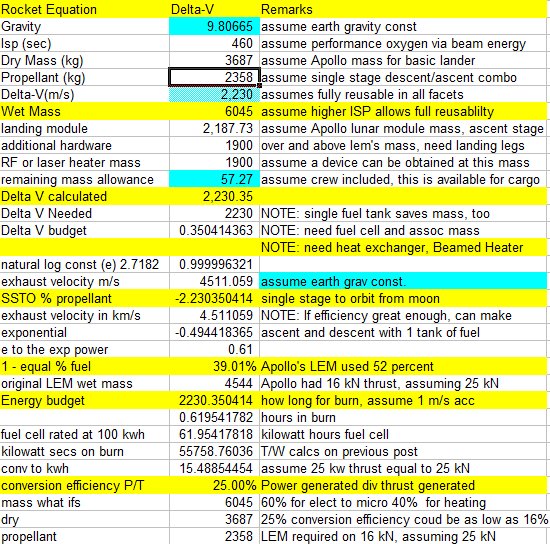I've been researching the topic, and found some interesting stuff. A single VASIMR engine can tow 7 metric tons to a low lunar orbit. If you can keep the weight of a theoretically reusable Lunar Module under that, you can get your Lunar Module into place for a sortie on the lunar surface. The ascent stage for the Apollo programs was less than 5 metric tons. So, if you can do this, you can have the lion's share of an architecture that can do this type of job, and it could all be fully reusable. One more thing is that the VASIMR can't take the astronauts. Some other means needs to be found for that.
I'll stop here and post this as an introduction. I'll update it as the day goes along. Keep tuned.
Update:
The original post on this subject, I assumed 10,000 kg. There were some errors in the spreadsheet, so I calibrated it, so to speak, by filling in the spreadsheet using Apollo data:
 |
| Gives us our baseline spacecraft |
 |
| Does saving 1350 kg in fuel help us? |
 |
| Maxxed out at 7000 kg, but this is too heavy for my taste. Can we lighten it up a little? |
I found that by using oxygen, it got too heavy, so I deleted some mass. Hopefully, the configuration is feasible.
 |
| Mono propellant reaction mass using oxygen, with ISP of 460, the same as for hydrogen combustion |
I think that it isn't assuming too much that an oxygen only propellant can achieve an ISP at the upper range of a conventional hydrogen oxygen combustion engine. Thus, we are adding 1500 kg in wet mass without needing more fuel. We can replace the existing rocket engines and add our new hardware, while hopefully remaining under the weight limit. (cross your fingers)
If this can be achieved, the entire lunar surface is available to us.
Update:
It looks like getting oxygen out of moon rocks may be more of a challenge that I thought. ( What else is new?) Anyway, it would be a great idea to go to the lunar poles first, and get situated there.
It turns out that you can obtain your oxygen from the iron oxides on the moon, but you have to beneficiate them first, then use a redox reaction to get the oxygen out. You get the oxygen out in the form of water or carbon dioxide, depending upon what reducing agent you use- hydrogen or carbon monoxide. You will at least need a source of hydrogen, and also carbon, which may be available at the poles as well.
I was thinking at some point, you'll want to move from the polar regions to get towards all of the lunar surface area. You can use lunar oxygen as the reaction mass, you can hop across the surface using nothing more than that as a transportation fuel. Technically, it would use hydrogen and oxygen in fuel cells, but these elements can be regenerated from the water that the fuel cell produces. The sun would then be powering your machine, as the energy will be stored in the hydrogen, and thus making hydrogen as the energy carrier for solar power.
Once you have spread out from the polar regions, you can mine the surface for platinum group metals (pgms). Those can be exported to Earth and used there for the hydrogen economy.
Oh, by the way. You may wonder: why oxygen? Doesn't that present a problem with oxidizing everything? It turns out that the Space Shuttle's thermal protection used a material that wouldn't oxidize even during the heat of reentry. You can use that for your heat exchanger. Parkin's microwave thruster, upon which this idea is based, does the same.
Update: 10/23/11
It looks as if my idea has a serious flaw. Or at least one serious flaw that I now know about. The energy calculations are off. So this idea appears to be off the table. &^*$!!!!.
No comments:
Post a Comment